Although a relatively small state, Indiana is home to an impressive 422 recorded species of birds. One of the families that you’re most likely to encounter, especially at your backyard bird feeders, are sparrows.
There are 15 resident sparrow species in Indiana, and at least 5 more can be seen passing through the state on their annual migrations.
Because the state lies at a central point on many bird’s migratory ranges, it is the northernmost territory for many sparrows during winter, and several other species come to nest here in summer.
Indiana is divided into two distinct climate zones, with the southern half being categorized as humid subtropical, and the northern half as hot summer humid continental.
This means that some of the sparrows can only be found in certain parts of the state during the various times of the year.
Let’s take a closer look at the 15 resident sparrow species in Indiana, starting with the most common, along with tips on how to identify this tricky family of ‘little brown jobs’!
15 Sparrows That Live in Indiana
Song Sparrow

- Scientific Name: Melospiza melodia
- Length: 4.7-6.7 in (12-17 cm)
- Weight: 0.4-1.9 oz (12-53 g)
- Wingspan: 7.1-9.4 in (18-24 cm)
The song sparrow is one of the most common sparrows across the United States and the most common of all in Indiana.
The appearance of these medium-sized sparrows can easily be confused with many other species, but it’s their constant song that, once learned, makes them easily identifiable.
Song sparrows are more frequently seen during summer in Indiana when huge numbers of them breed in the state, but there are also plenty in winter.
During the colder months, you can easily attract these noisy birds to your backyard feeders by offering them cracked corn, black oil sunflower seeds, and other grains.
House Sparrow

- Scientific Name: Passer domesticus
- Length: 5.9-6.7 in (15-17 cm)
- Weight: 0.9-1.1 oz (27-30 g)
- Wingspan: 7.5-9.8 in (19-25 cm)
House sparrows aren’t native to Indiana, or any other state in America. They were brought to New York in 1852 by European settlers to control insect populations. Not surprisingly, their numbers quickly got out of control, and they spread across the entire country.
Now seen everywhere, house sparrows are the second most commonly seen sparrow in Indiana. Their presence sometimes concerns ornithologists, since these dominant birds sometimes take over the nesting grounds of native species.
House sparrows, belonging to a different family from native American sparrows, don’t migrate but stay within the same territories year-round.
Despite their status as an invasive species, their cheerful chirps and friendly character makes them fun birds to have around whether in the countryside or the city.
Dark-eyed Junco
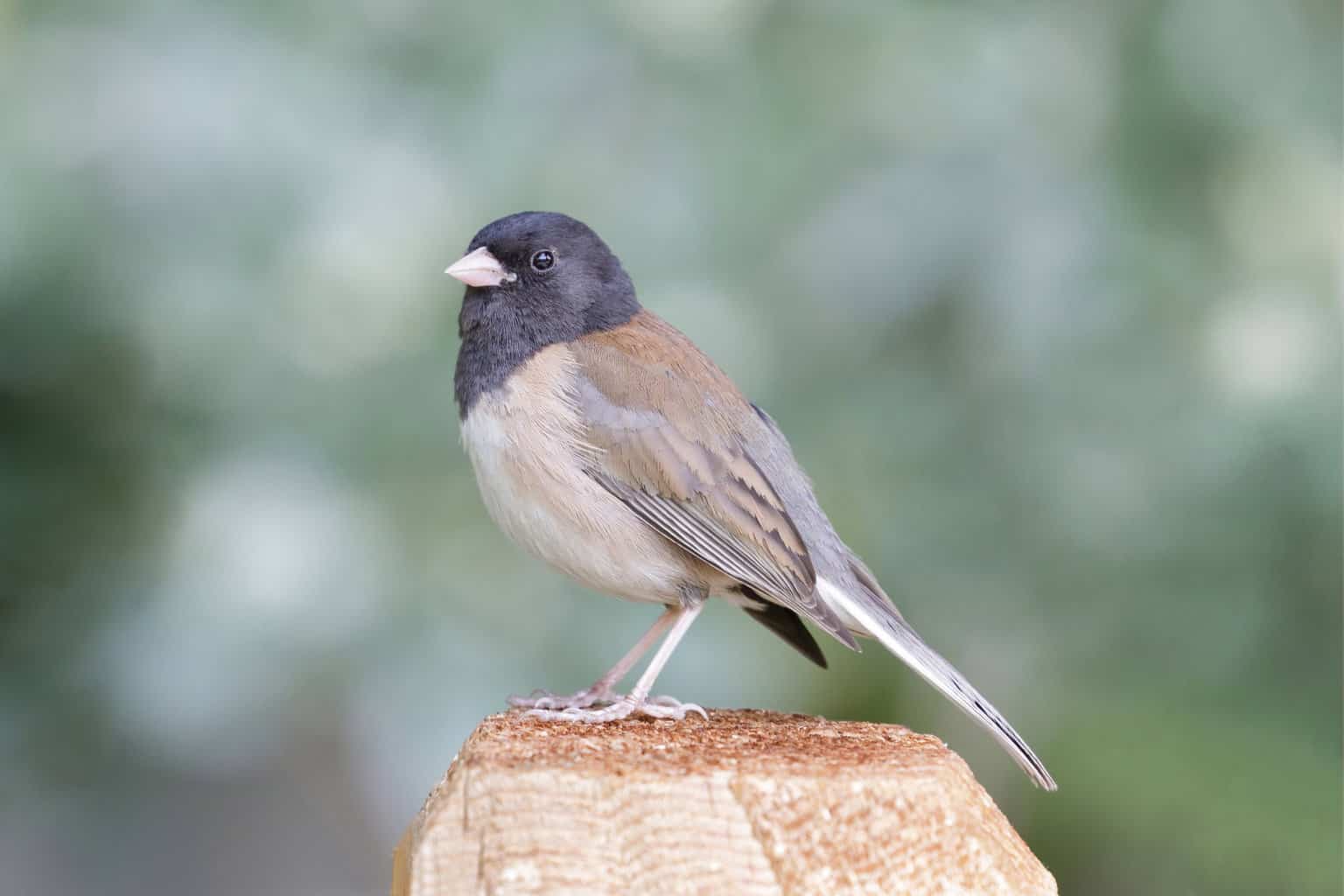
- Scientific Name: Junco hyemalis
- Length: 5.5-6.3 in (14-16 cm)
- Weight: 0.6-1.1 oz (18-30 g)
- Wingspan: 7.1-9.8 in (18-25 cm)
Dark-eyed Juncos are sometimes known as ‘snow birds’ because they appear to be so hardy. Indiana is merely an overwintering ground for this dark gray sparrow that prefers to breed further north.
Although there are various sub-species of dark-eyed juncos across the United States, the ones that you’ll see in Indiana will almost always be the slate-colored variety. The black-headed Oregon dark-eyed junco is only a very rare vagrant here.
You can easily attract dark-eyed juncos to your backyard at this time of the year by offering them snacks at your backyard bird feeder.
Chipping Sparrow
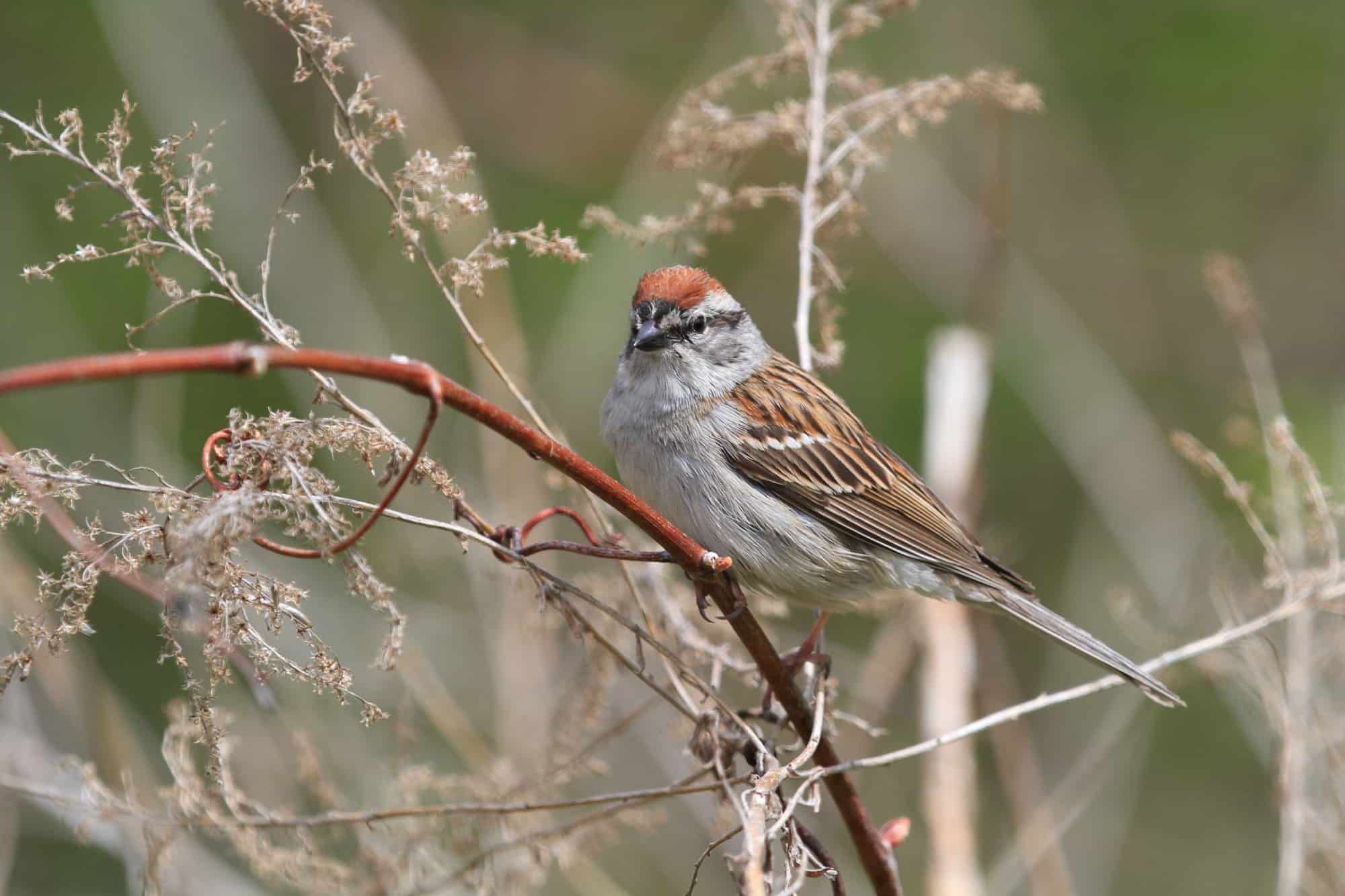
- Scientific Name: Spizella passerina
- Length: 4.7-5.9 in (12-15 cm)
- Weight: 0.4-0.6 oz (11-16 g)
- Wingspan: 8.3 in (21 cm)
During the breeding season, all of Indiana is full of chipping sparrows busy nesting in shrubs and trees.
In winter, most individuals fly to more southerly states and even Central America. Only small populations remain in the southern part of the state for the colder months.
Chipping sparrows can be recognized by their rusty crown feathers, black eye lines, and gray chests. Their stuttered trilling call is also fairly distinctive – think of the sound of a high-pitched squeaky wheel that needs some serious greasing!
Eastern Towhee

- Scientific Name: Pipilo erythrophthalmus
- Length: 6.8-8.2 in (17.3-20.8 cm)
- Weight: 1.1-1.8 oz (32-52 g)
- Wingspan: 7.9-11.0 in (20-28 cm)
They might not look or sound like a sparrow, but the Eastern towhee is just as much part of the New World Sparrows as any of the others on our list! These beautiful birds have a black head, wings, and tail, dark, ruby red eyes, rusty red flanks, and a white belly.
Indiana is right on the edge of the Eastern towhee’s year-round range, so you’ll only find them in the northern part of the state during the summer months. A few remain through the winter in the low-lying, sub-tropical areas in the south of the state, as well.
An interesting fact about the Eastern Towhee is that they’re often the victims of brood-parasitism of Brown-Headed Cowbirds.
Just like a cuckoo, the cowbirds remove the Eastern towhee’s eggs from their nest and lay their own. If the towhees don’t notice the trick, they’ll end up raising the cowbirds young!
White-throated Sparrow
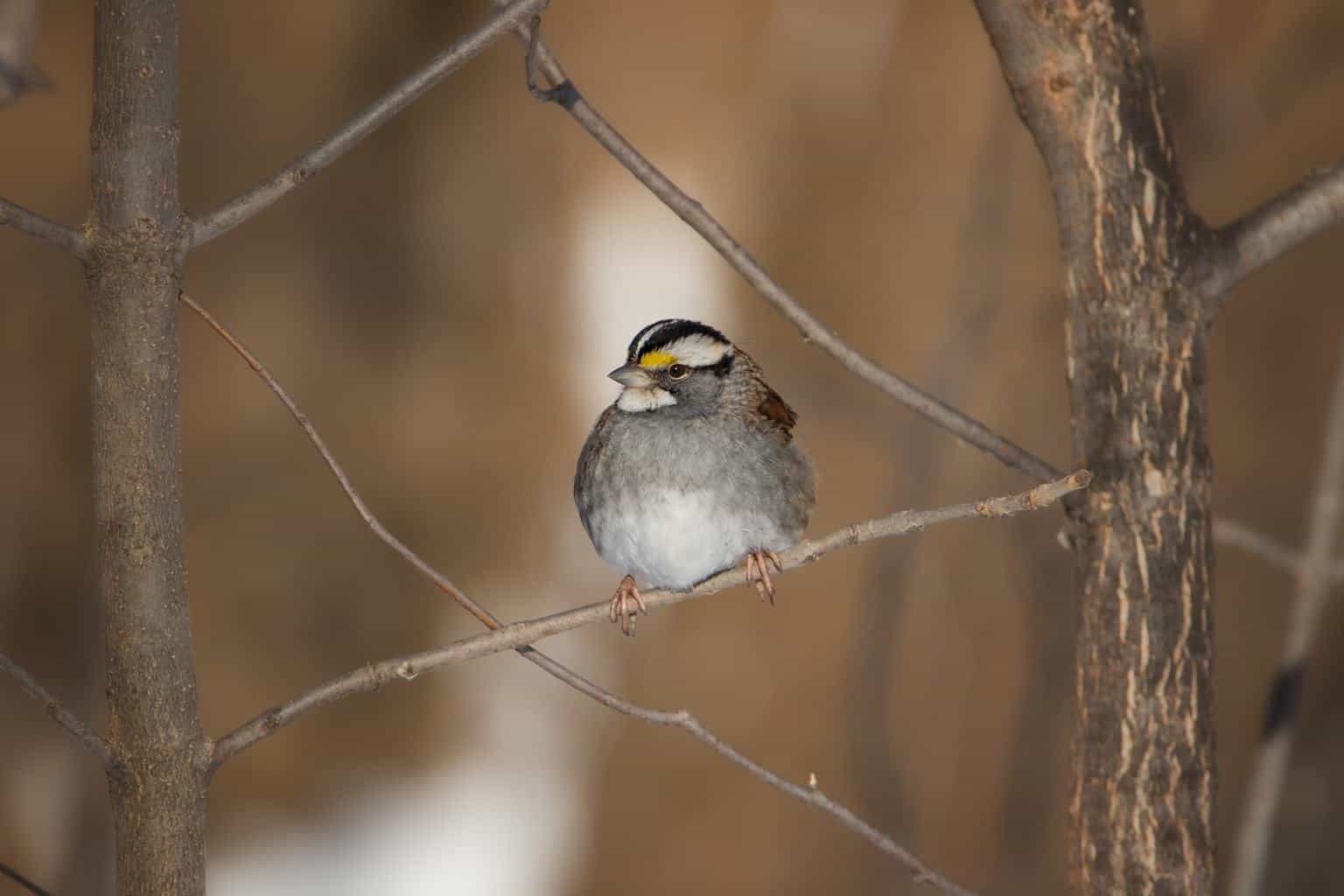
- Scientific Name: Zonotrichia albicollis
- Length: 6.3-7.1 in (16-18 cm)
- Weight: 0.8-1.1 oz (22-32 g)
- Wingspan: 7.9-9.1 in (20-23 cm)
The white-throated sparrow is fairly easy to recognize from its black and white (or sometimes tan) striped head, yellow eyebrows, and white throat/chin.
These medium-sized sparrows are hardy little critters and only stay in Indiana during winter. In summer they nest mainly in Canada and a few of the northernmost states of the US.
While they’re a fairly common sight during the colder months, you’re more likely to see them during the spring and fall migrations.
These are easy sparrows to attract to your backyard and woodland bird feeders.
Field Sparrow
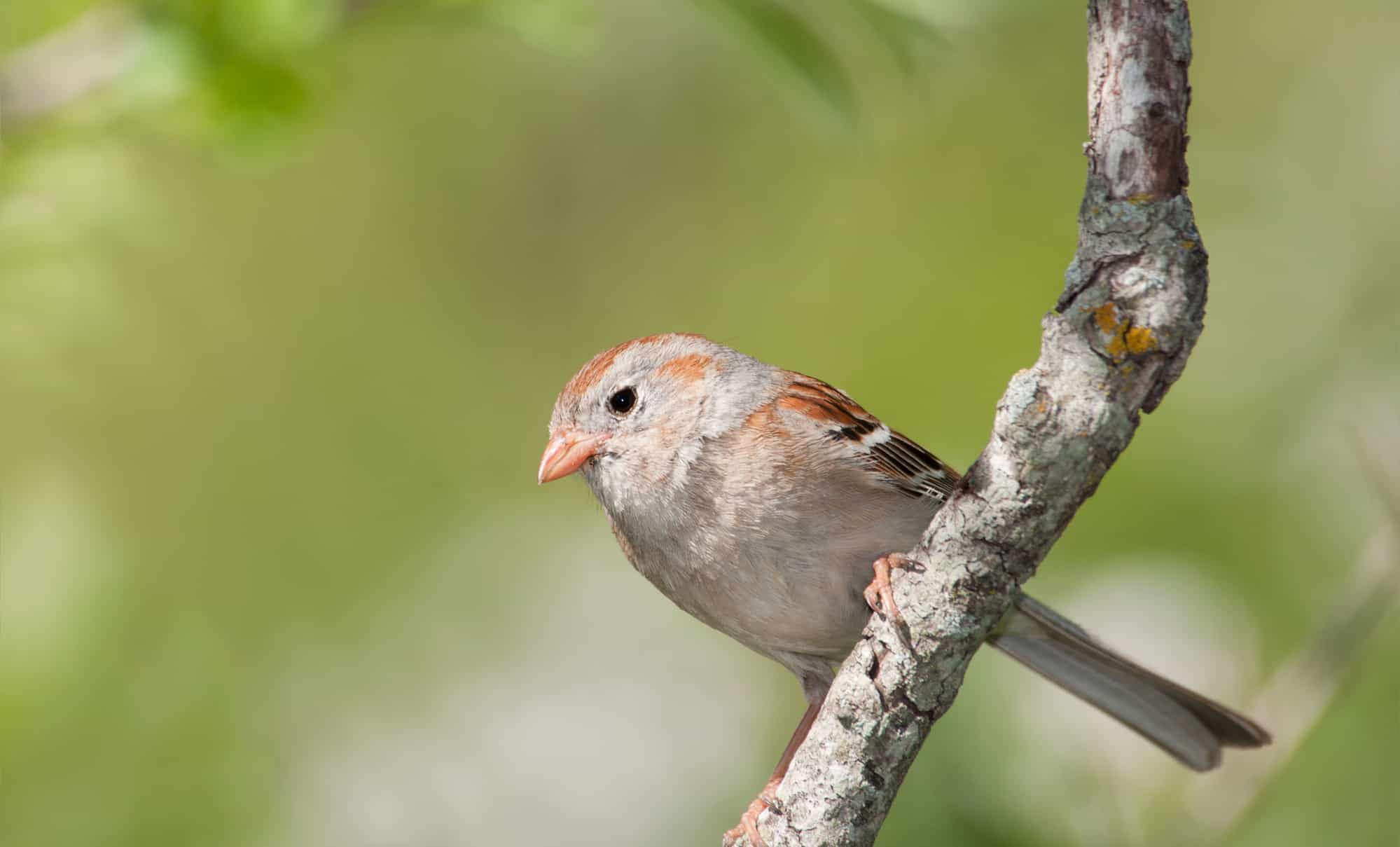
- Scientific Name: Spizella pusilla
- Length: 4.7-5.9 in (12-15 cm)
- Weight: 0.4-0.5 oz (11-15 g)
- Wingspan: 7.9 in (20 cm)
Field sparrows are a common sight in Indiana during the summer when large numbers of them come to breed here. Only a very few remain in the state during the winter months.
Although this medium-sized sparrow is fairly difficult to distinguish by appearance alone, they can be told apart from other similar-looking species by their loud, high-pitched call that sounds a bit like a bouncing ball coming to a stop!
Field sparrows nest on the ground and, once hatched, their young only takes about one week to fledge!
American Tree Sparrow
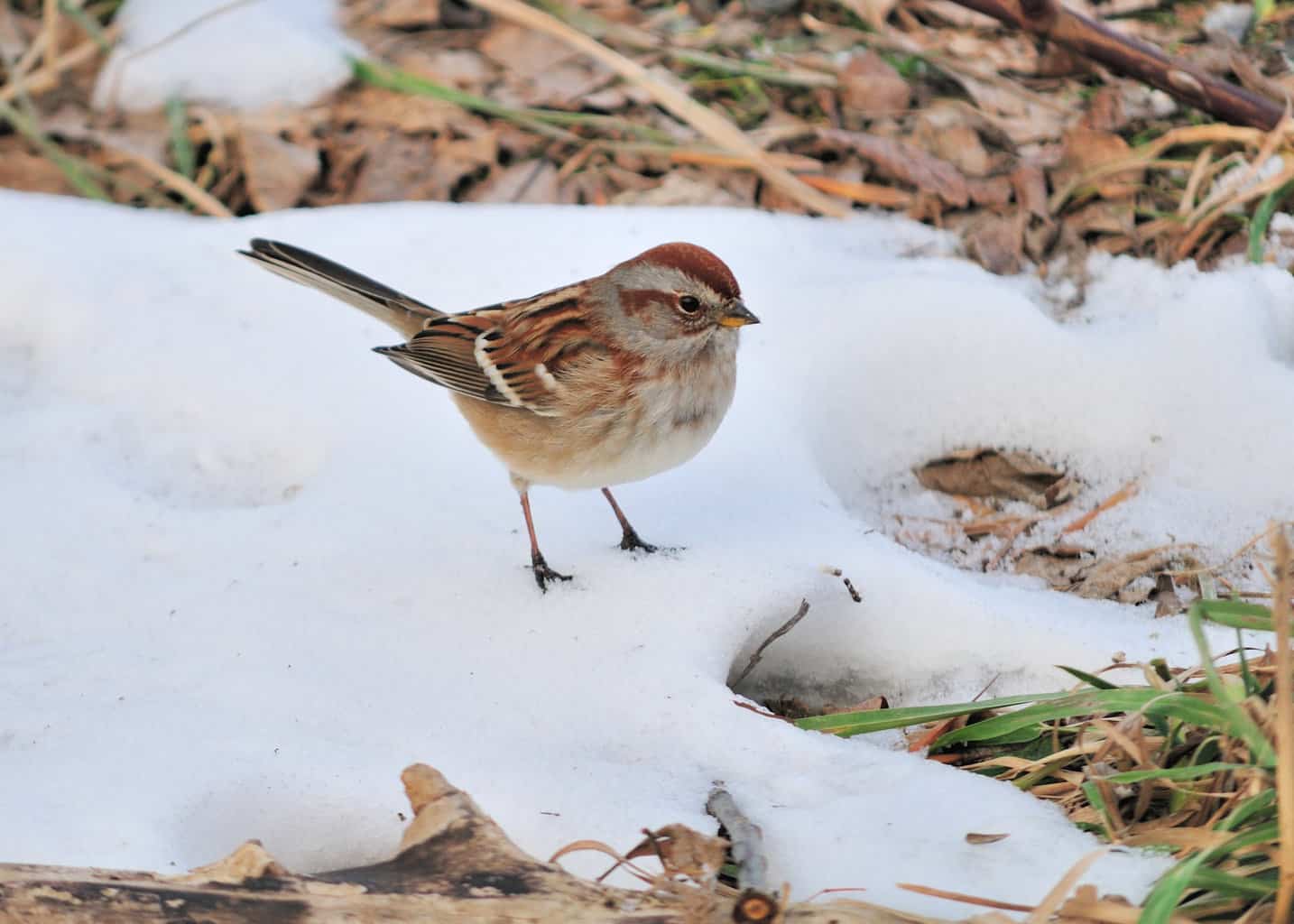
- Scientific Name: Spizelloides arborea
- Length: 5.5 in (14 cm)
- Weight: 0.5-1.0 oz (13-28 g)
- Wingspan: 9.4 in (24 cm)
The American tree sparrow is another bird that likes to nest in the far north – their breeding range extends well into the arctic circle!
Like the white-throated sparrow, they only stay in Indiana during winter, but large flocks also pass through the state during the spring and fall migrations.
This sparrow’s name is a misnomer. It was so-called by European settlers who thought that it reminded them of their native tree sparrow.
In fact, the American tree sparrow spends little time in trees, and you’re more likely to see them near the ground!
These birds are closely related to the field sparrow and have similar plumage. They are much larger, however, and have a different song that’s sweet and pleasant to hear.
White-crowned Sparrow
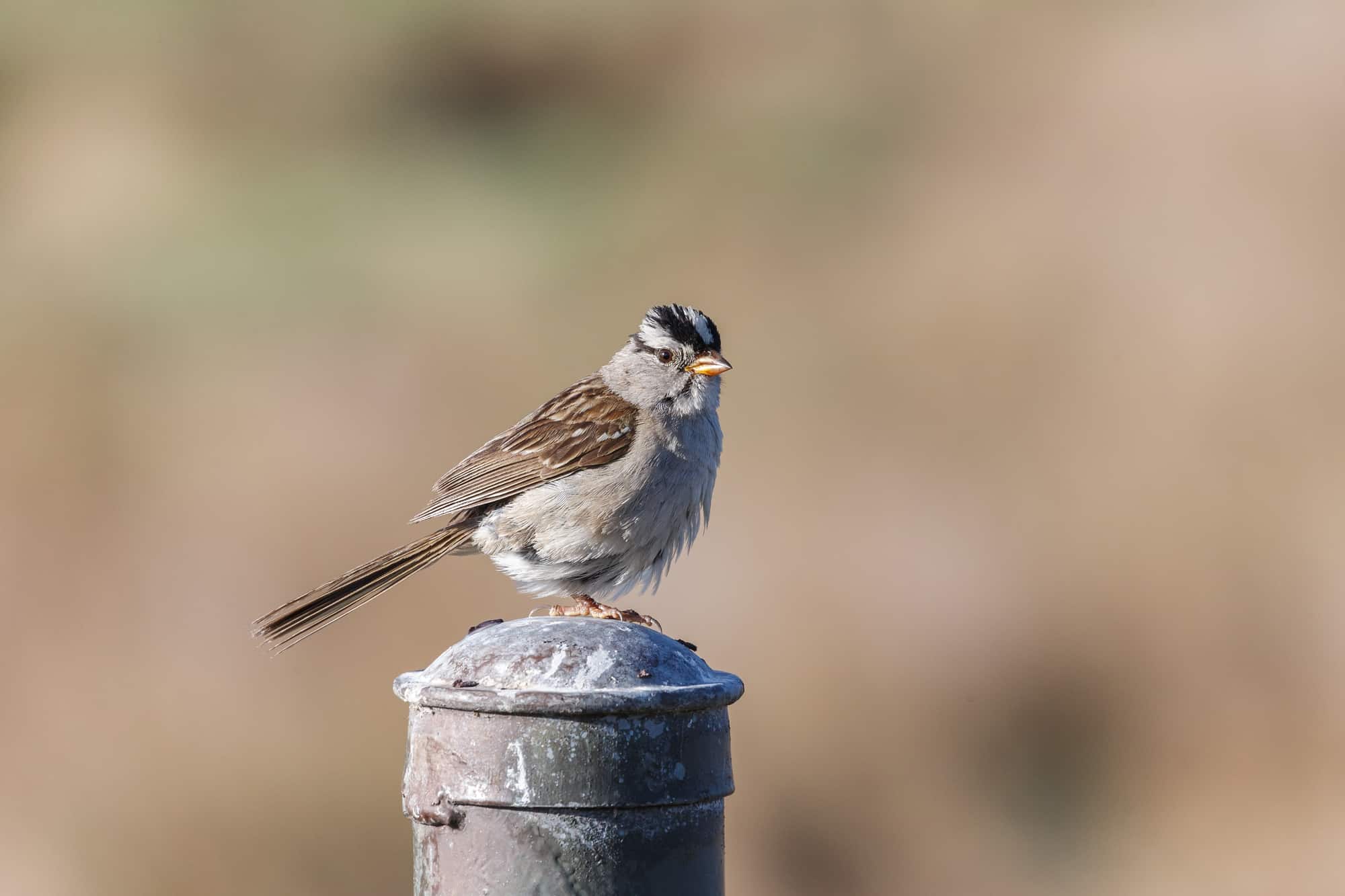
- Scientific Name: Zonotrichia leucophrys
- Length: 5.9-6.3 in (15-16 cm)
- Weight: 0.9-1.0 oz (25-28 g)
- Wingspan: 8.3-9.4 in (21-24 cm)
The white-crowned sparrow is one of the largest members of the Zonotrichia tribe of sparrows. They’re fairly easy to recognize by the black and white stripes on their head, and orange-pink bill.
Indiana represents the northernmost wintering ground for this big sparrow, which spends the summer in the far north of Canada, Alaska, and the Rocky Mountains.
You can find them moving around in large flocks over weedy and brushy areas and you can also attract them to your backyard by offering them sunflower seeds, millet, and other types of bird food.
Swamp Sparrow
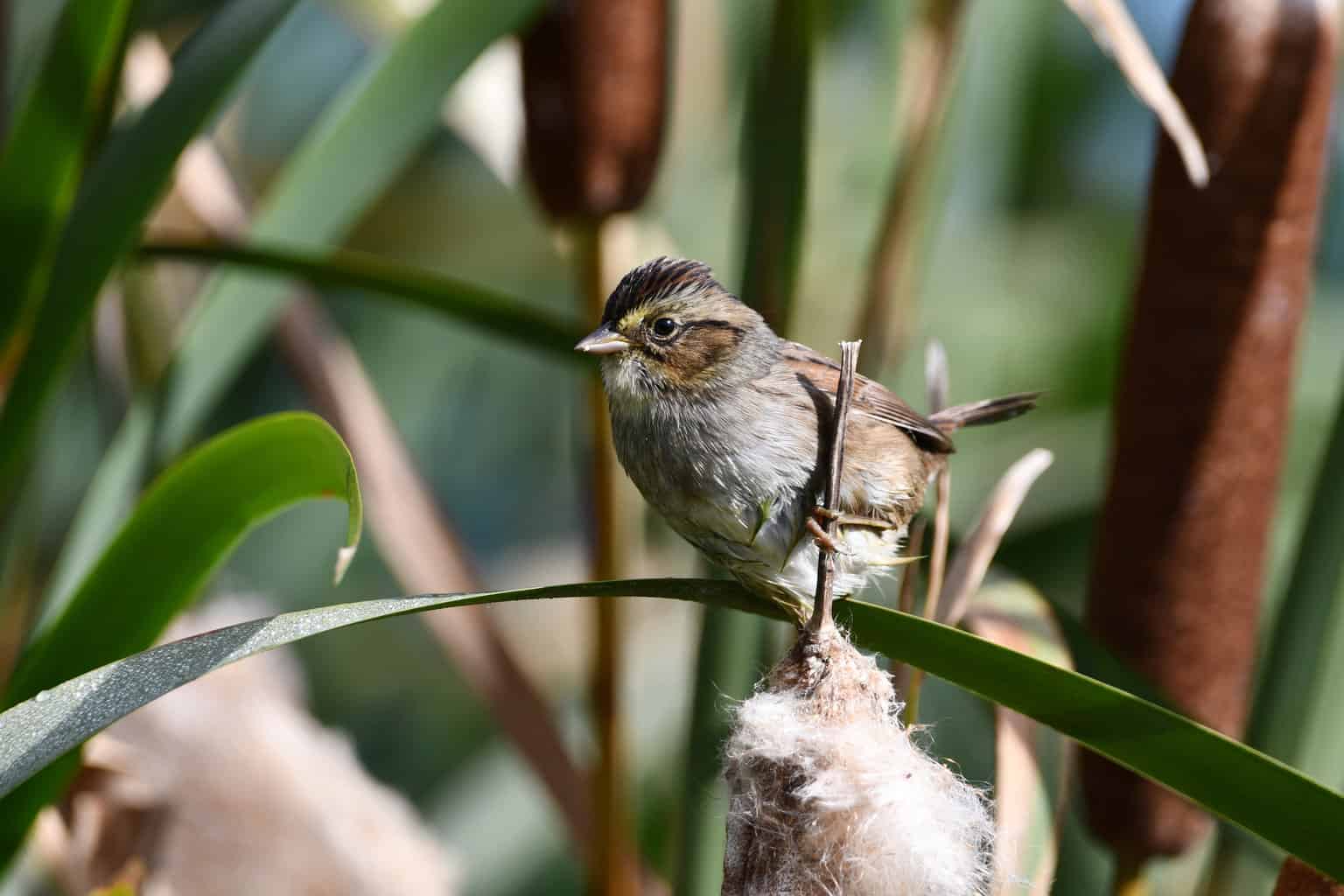
- Scientific Name: Melospiza georgiana
- Length: 4.7-5.9 in (12-15 cm)
- Weight: 0.5-0.8 oz (15-23 g)
- Wingspan: 7.1-7.5 in (18-19 cm)
Swamp sparrows are primarily migratory birds in Indiana, but a few can be seen throughout the year in the wetland habitats that they prefer.
This tiny bird doesn’t often come near human habitation and is so shy that its presence often goes unnoticed.
If you are camping out in the countryside, you might hear its simple song, a series of one-note whistles, before dawn breaks.
Although these birds usually remain in marshes and swamp land, swamp sparrows may occasionally be attracted to backyards if you offer them a garden pond or bird bath, especially during the migration seasons.
Savannah Sparrow
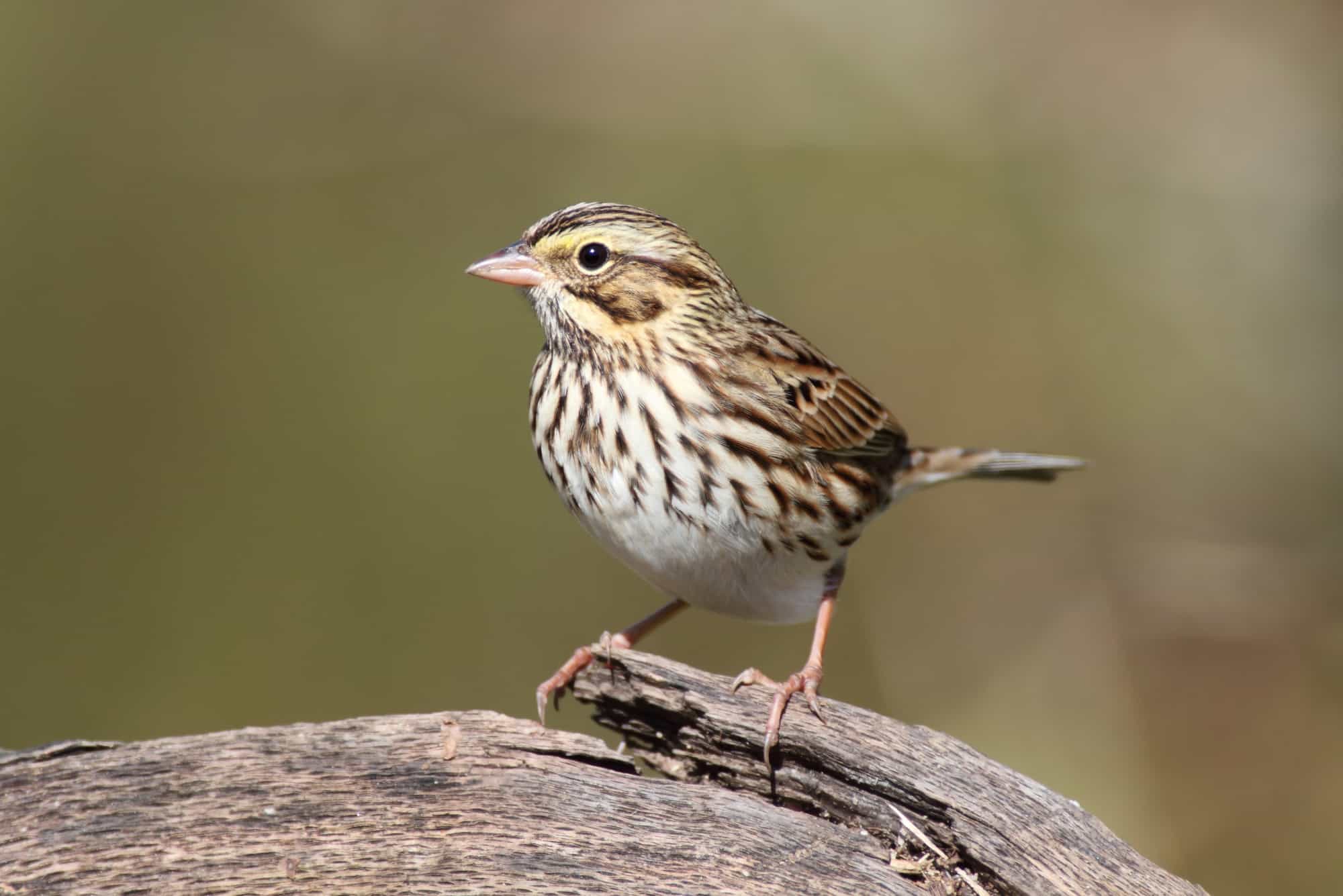
- Scientific Name: Passerculus sandwichensis
- Length: 4.3-5.9 in (11-15 cm)
- Weight: 0.5-1.0 oz (15-28 g)
- Wingspan: 7.9-8.7 in (20-22 cm)
Although savannah sparrows are widespread across North America, you won’t see them every day in Indiana. These large sparrows are not so numerous here, and also prefer to stay out in open grasslands, away from human habitation.
The north of the state represents its southernmost breeding ground, and the south of the state is at the northern edge of its winter grounds. According to the Sibley Guide To Birds, they’re only present in central Indiana during migration.
- Sibley Guide To Birds, 2nd Ed
- Sibley, David Allen (Author)
- English (Publication Language)
Last update on 2024-07-26 / Affiliate links / Images from Amazon Product Advertising API
Although they look rather like song sparrows, they can be identified through a pair of binoculars by the yellow wash around their face.
Henslow’s Sparrow
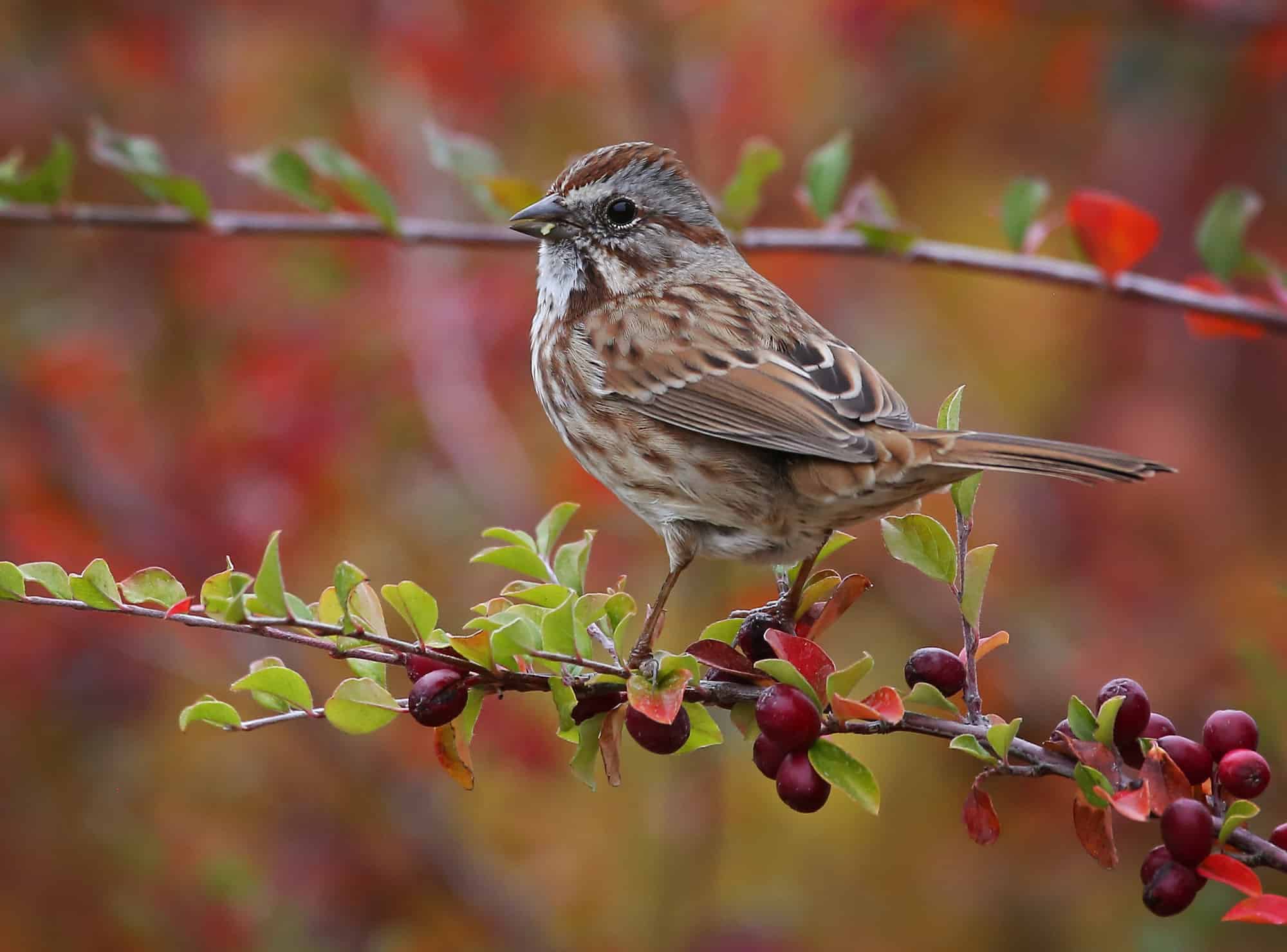
- Scientific Name: Centronyx henslowii
- Length: 4.75 – 5.25 in (12 – 13 cm)
- Weight: 0.5 oz – (14 g)
- Wingspan: 6-7 in – (15 – 18 cm)
A yellowish sparrow with a short tail and a large head, Henslow’s sparrow is one of the smallest sparrows in North America.
A rather rare and regional species, Indiana lies right at the heart of the small breeding range of these birds. They spend the rest of the year in the southeast of the USA.
Since Henslow’s sparrow is so small, shy, and well-camouflaged, it should be considered a prized spotting in Indiana. Even its song is quiet and subtle, sounding more like an insect or mouse than a bird!
Grasshopper Sparrow
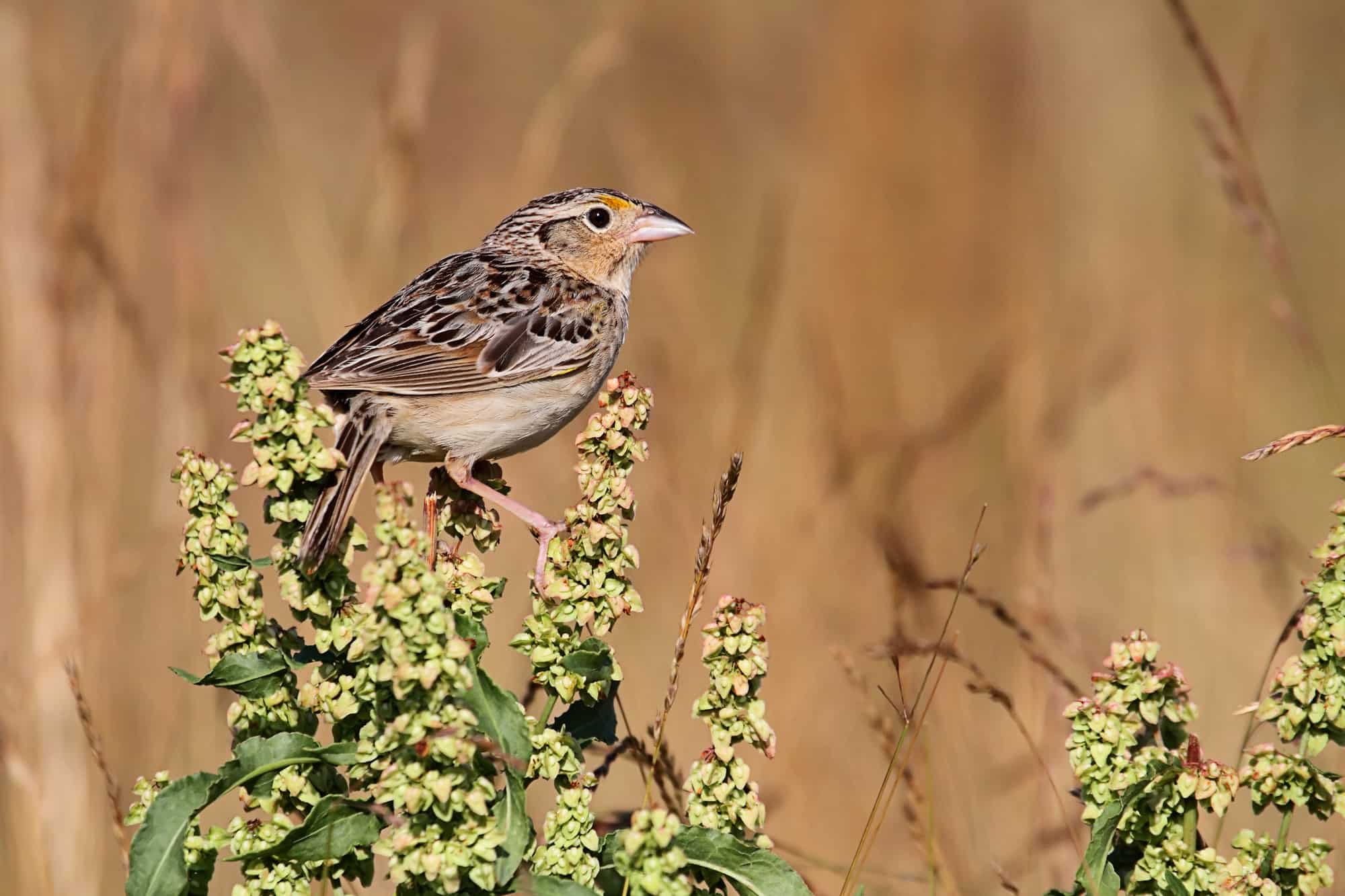
- Scientific Name: Ammodramus savannarum
- Length: 4.3-4.5 in (10.8-11.5 cm)
- Weight: 0.5-0.7 oz (14-20 g)
- Wingspan: 7.9 in (20 cm)
Another tiny bird with an insect-like call, the grasshopper sparrow not only sounds like a grasshopper but also loves preying upon them during the summer when they nest in dry grasslands.
Summer is the only time of year when you’ll find these birds in Indiana – they spend their winters solely in the southernmost United States and Central America.
Although they look like LeConte’s sparrow that passes through the state on migration, they are substantially larger and favor dry habitats over the damp grasslands associated with their cousin.
Vesper Sparrow
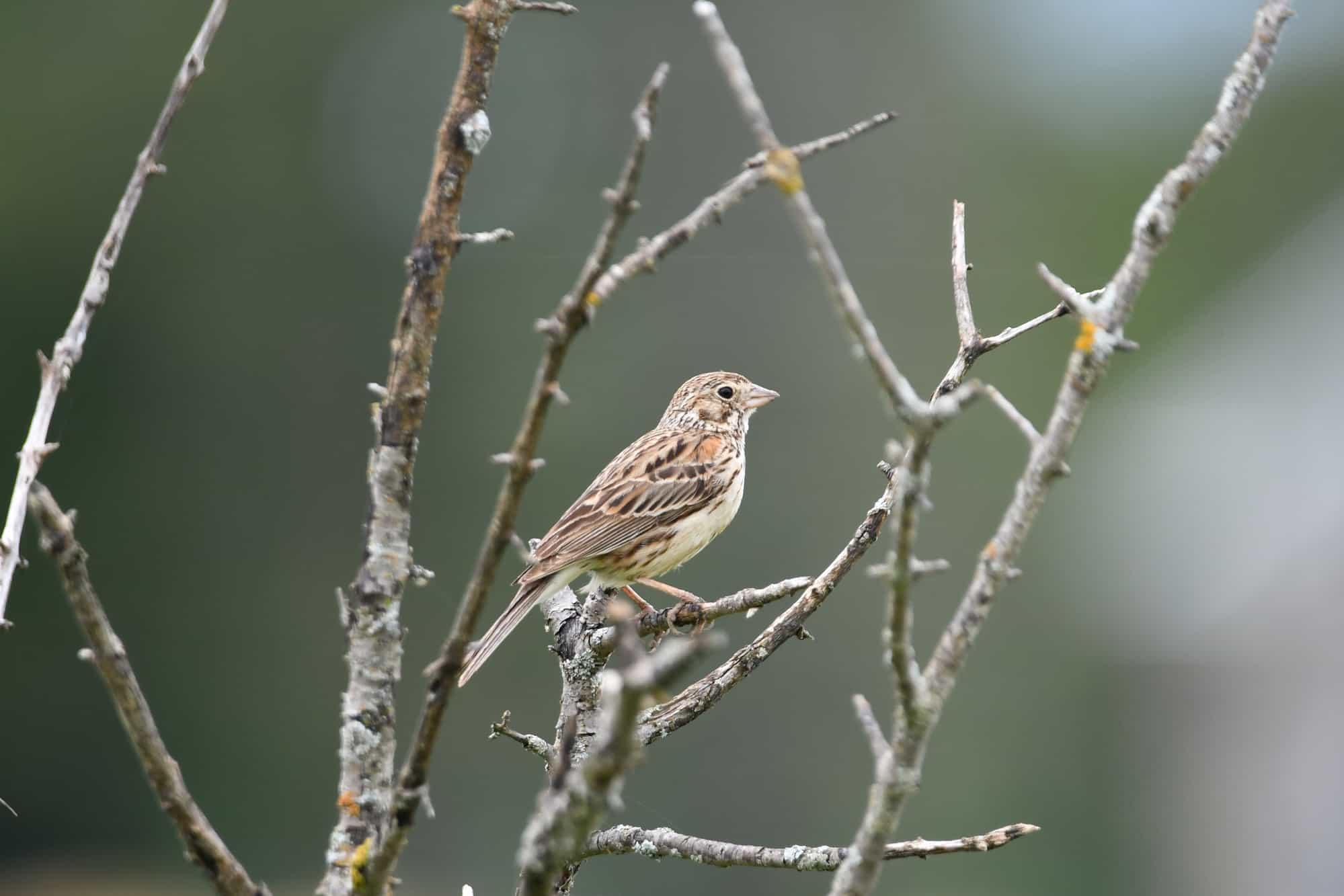
- Scientific Name: Pooecetes gramineus
- Length: 5.1-6.3 in (13-16 cm)
- Weight: 0.7-1.0 oz (20-28 g)
- Wingspan: 9.4 in (24 cm)
The vesper sparrow is similar in appearance to the Savannah sparrow, but it’s slightly larger and doesn’t have a yellow wash on its face.
Although they’re a common bird in the west of the country, vesper sparrows are relatively rare in Indiana. You’ll only find them here during the summer when they nest in all areas except the southern fringes of the state. In winter, they migrate to the Southern United States and Central America.
Vesper sparrows nest in extensive grasslands, meaning the preservation of wild meadows is essential for them to thrive for years to come.
Lark Sparrow
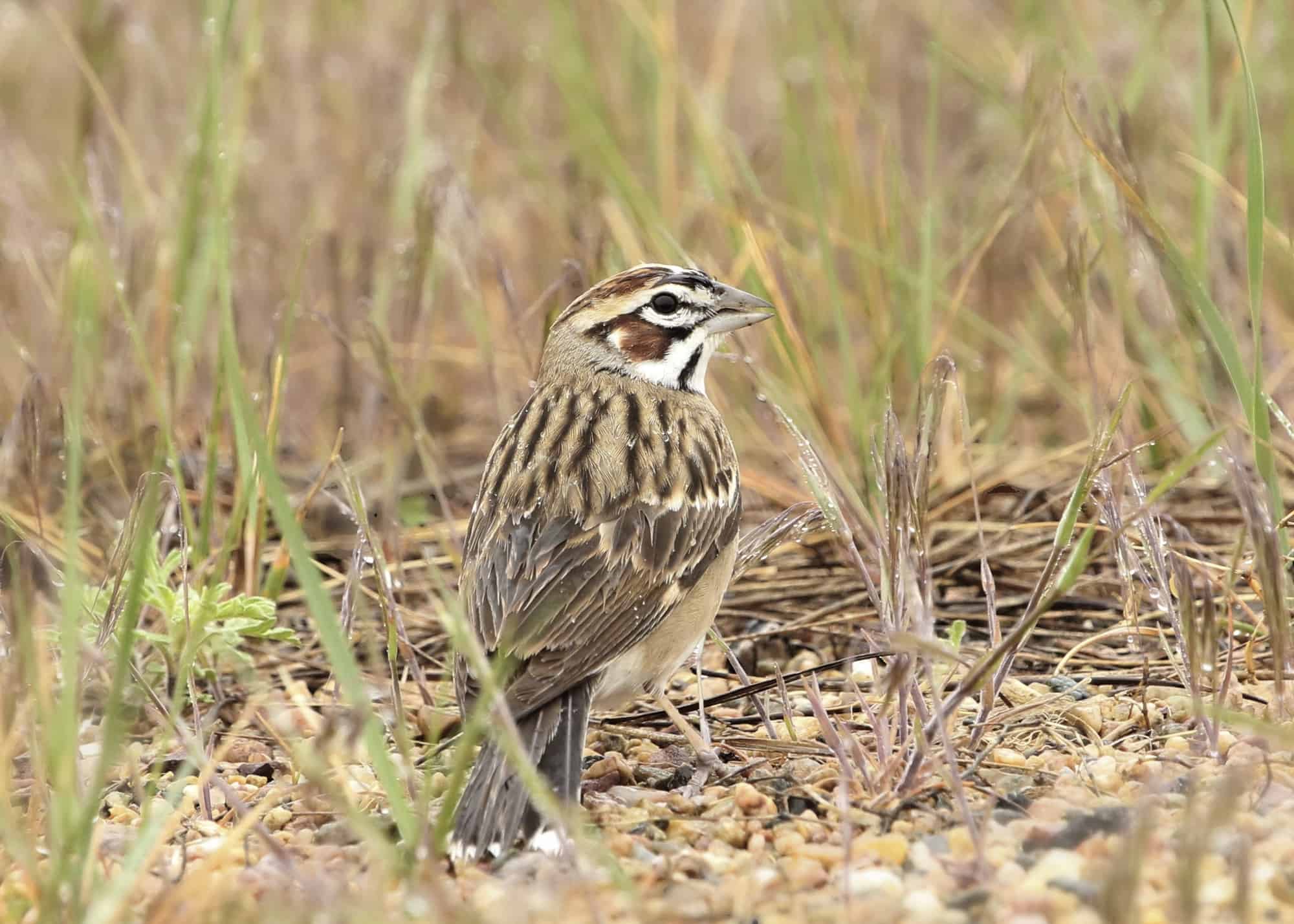
- Scientific Name: Chondestes grammacus
- Length: 5.9-6.7 in (15-17 cm)
- Weight: 0.8-1.2 oz (24-33 g)
- Wingspan: 11.0 in (28 cm)
Lark sparrows are probably the rarest of all resident sparrows in Indiana, and can only be seen during the breeding season in the western parts of the state.
Not to be confused with their striking cousin the lark bunting, lark sparrows are most easily recognized by their very large size, the bright white underside with a dark spot on their chest, and the white tips on their tail. Closer inspection also reveals distinct black stripes on their face and a tan crown.
Although more common further west, your best chance of seeing these large sparrows in Indiana is in open grasslands where they build nests on the ground or in low trees. Males also perform an entertaining courtship dance during the spring!
Sparrows Only Seen in Indiana During Migration
Because Indiana is such a central state on migration routes, several sparrows merely pass through the state during spring and fall, without stopping for long.
The most likely passing migrants you’ll see in the sparrow family are the large, thrush-like fox sparrows, and Lincoln’s sparrows, which are famous for their sweet whistling song.
Less commonly seen during migration are the Clay-colored sparrow, LeConte’s sparrow, Harris’s sparrow, and Nelson’s sparrow.
Conclusion
Indiana has 15 resident sparrow species and at least 5 more that can be seen during the migration season. While many of these species may appear similar, getting to know the nuanced differences can be a rewarding part of improving your bird-watching skills!
Utilizing backyard bird feeders is one of the best ways to get to know sparrows in closer proximity, making it easier for you to identify them in the field later.
Sparrows makeup but a tiny part of the 422 bird species that can be seen in the Hoosier state, so if you’re keen to learn about the best of the rest, don’t miss our guide to 27 of the most impressive birds in Indiana!

